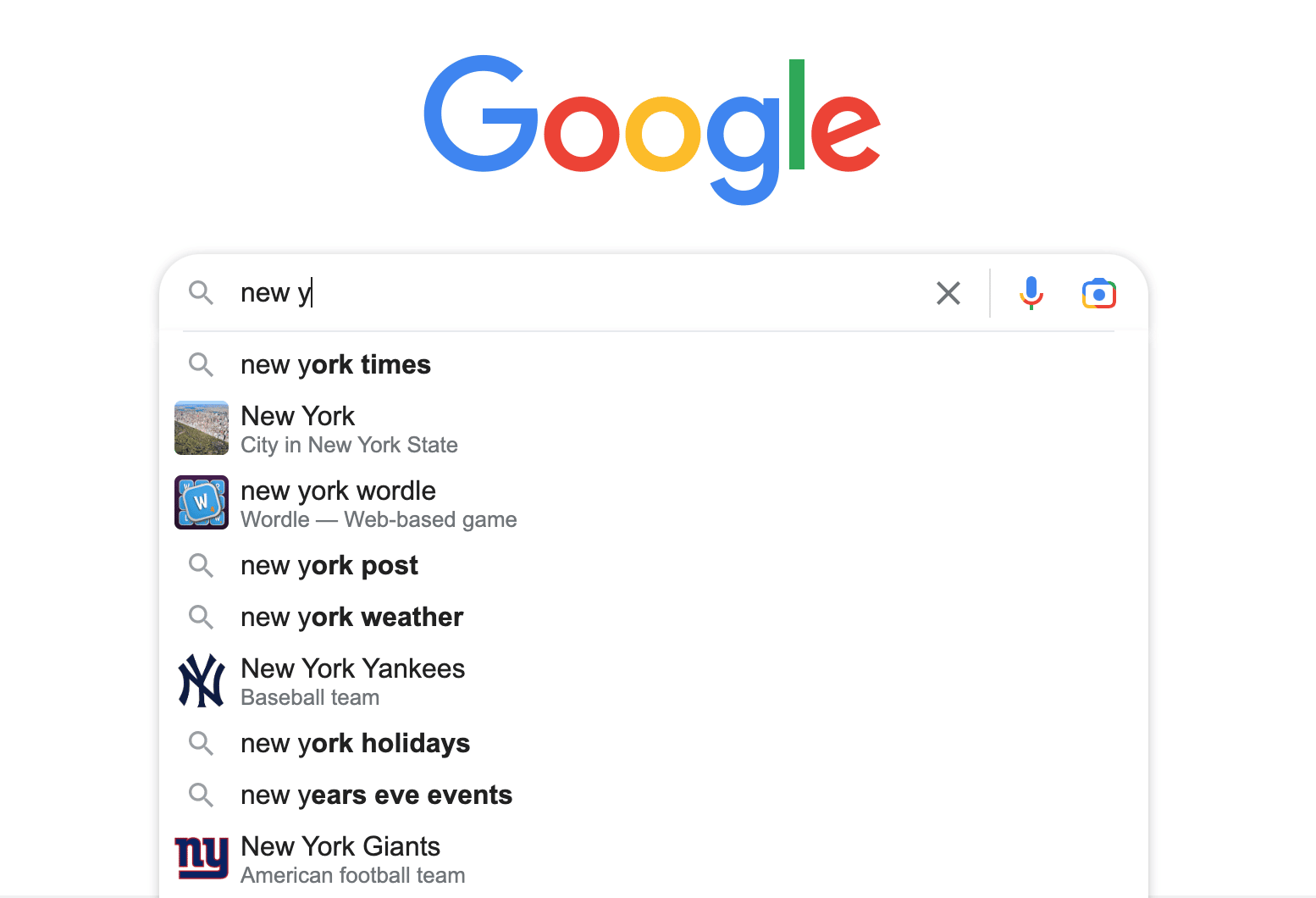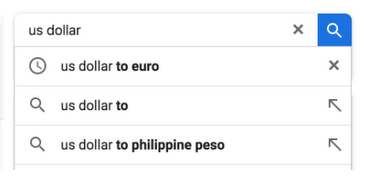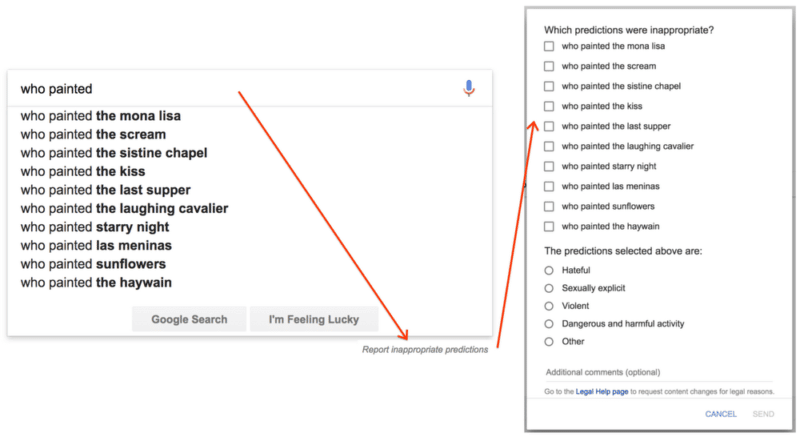When you go to the Google homepage, you’ll most likely know what you’re about to type into the search box – whether you’re checking in on the weather forecast, looking for a business or service, or want to find out where you recognize that actor from. (Unless you’re “feeling lucky,” that is.)
You enter a word or a single letter, and Google will populate the search box with a list of “predictions” before you’ve even finished typing. This Google feature is called Autocomplete.
But what exactly is it? How does Google come up with those predictions? Read on to find out how Google Autocomplete works.
What is Google Autocomplete?
Autocomplete is a feature within Google Search that, in Google’s own words, is “designed to make it faster to complete searches that you’re beginning to type.”
Starting as an experimental feature in 2004, it was fully introduced four years later as Google Suggest and was renamed Autocomplete in 2010.
It is available anywhere you can expect to find a Google search box, including:
- The Google home page.
- The Google app for iOS and Android.
- The quick search box from within Android.
- The “Omnibox” address bar within Chrome.
Begin typing, and you’ll see predictions appear.

In the screengrab above, you can see that by typing “new y” Google brings up predictions such as “new york times” or “new york Yankees.”
This makes it easy to finish entering your search on these topics without typing all the letters. The predictions change in real-time in response to each character being typed into the search box.
The user then has the option to continue typing their desired query or choose from the dropdown selection.
But if you know what you’re searching for, why do you need Google to tell you?
It saves time. While Autocomplete began as a desktop search feature all those years ago, it has become a popular time-saving feature on mobile devices.
Google estimates that, cumulatively, it saves the equivalent of over 200 years of typing every single day and, on average, reduces typing overall by about 25%.
How Google Autocomplete works
Google Search doesn’t quite know how to read minds. Instead, it makes calculated predictions by looking at searches made by real people.
Autocomplete displays common and trending queries relevant to the characters entered into the search bar.
Here are some key factors used by Autocomplete to predict search queries:
- Overall popularity.
- Trending topics.
- Search history.
- Location.
Put simply, the results shown are influenced by things you’ve previously searched for, the location you’re searching from, and the search term data that Google has gathered – using all of this data to automatically predict what you’re looking for.
Let’s take a closer look at each factor.
The popularity of search queries
When it comes to predicting search queries, popularity often walks hand in hand with what’s trending. But trends can fade over time, whereas one or more subjects might always be commonly linked together.
While some searches are far more common than others, some less popular searches might be shown above more common ones if Google deems them more relevant, the company says. In short, personalized > popular.
Trending searches
We’ve all heard of Google Trends, the website that analyzes the popularity of top search queries across various regions and languages. Well, this isn’t that.
A current trending search is a term or phrase that suddenly spikes in popularity. As people flock to Google to ask the same question, the query can appear as a suggestion, even if it hasn’t gained long-term popularity.
Google uses the following example to explain:
When actress Anna Paquin was getting married, “Anna Paquin wedding” began appearing as a suggestion just before her big day. The term was useful to suggest, as many people were starting to search for it.
If Google had relied solely on long-term data, then the “suggestion” wouldn’t have appeared as an option in the search box, as it hadn’t widely been searched for previously.
And today, Autocomplete no longer offers the term as it didn’t harness enough long-term popularity (though “Anna Paquin married” has stuck).
Previous search queries
The predictions dropdown list will include a variation of topics and questions depending on who is doing the searching. To speed up the search process and identify what you might be looking for, Google sifts through your past searches.
In the example below, you can recognize that a previous search result appears because the text is highlighted in purple.

On desktop, you’ll also see the word “Remove” appear next to the prediction, which you can click if you want to delete the past search.
However, on mobile, things look a little different. You’ll see a clock icon on the left for previous searches and an X button on the right to remove it.

You can also delete all your previous searches in bulk or by particular dates or those matching particular terms using My Activity in your Google Account, regardless of the device you use to search.
Language and location
With a service that seems so personalized, it’s perhaps no surprise that not everyone receives the same suggestions. Among the factors that can tailor your experience is the language you’re searching in and the location you’re searching from.
The country, the state or province, and even the city can all produce different suggestions – whether it’s where you currently live or are originally from.
Different suggestions will also appear if you’ve told Google that you prefer to search in a particular language or based on the language Google assumes you use, as determined by your browser’s settings.
Why are some predictions removed?
Google outlines that Autocomplete makes "predictions" rather than "suggestions."
This could be due to several controversial and legal claims previously made which suggested that Google was promoting harmful, offensive and/or inaccurate information by suggesting certain search queries.
When rebranding in October 2010, Google moved away from "Suggest" since it's not always offering the most thoughtful, caring, or appropriate term.
The company prefers to use "predictions" and is committed to bettering the service by taking on feedback and monitoring searches.
In addition, Autocomplete is designed to help people complete a search they intended to do. The feature offers predictions based on the query you were likely to continue entering.
While the results show depend on several factors outlined above, Google removes predictions that are against its autocomplete policies, which block:
- Sexually explicit predictions that do not cover or relate to medical, scientific, or sex education topics.
- Hateful predictions against groups and individuals based on race, religion, sexuality or other demographics.
- Violent or harmful predictions.
- Dangerous and harmful activity in predictions.
Google may also remove predictions considered spam, closely associated with piracy, or in response to valid legal requests.
How do inappropriate Autocomplete predictions happen?
While Google has systems designed to automatically catch inappropriate predictions, the search engine processes billions of daily searches.
Billions of searches mean billions of predictions, which means that sometimes, inappropriate predictions can slip through the net.
While some predictions may seem odd, shocking or make you question why someone might want to search for it, looking at the actual search results generated sometimes provides needed context.
In some cases, the search results themselves may make it clearer that predictions don't necessarily reflect awful opinions which some people may hold but instead may come from those seeking specific content that's not problematic.
This is why popular searches measured in our Google Trends tool might not appear as predictions within Autocomplete.
Google Trends is a tool designed as a way for anyone to research the popularity of search topics over time, regardless of the search intent.
How to report inappropriate Autocomplete predictions
If you spot something which doesn't feel right, makes you uncomfortable or might offend someone, you can report using the "Report inappropriate predictions" link, which appears below the search box on desktop.

For those searching on mobile or using the Google app for Android, long press on a prediction to get a reporting option. Those using the Google app on iOS can swipe to the left to get the reporting option.
Google reassures users that they don't just remove a reported prediction that violates their policies but also investigate closely related predictions to provide a broader solution and prevent inappropriate predictions from being made in the future.
More than just Autocomplete
Google Autocomplete benefits all types of users, helping them to make searches and load pages more quickly.
Whether you're looking to inform your marketing strategy, generate content ideas, research keywords or explore search intent, Autocomplete can be a valuable tool.
Search and digital marketers use it to find out what people are actively searching for so they can better meet their customers' needs.
The post How Google Autocomplete works appeared first on Search Engine Land.
from Search Engine Land https://ift.tt/EzxbihI
via
No comments:
Post a Comment